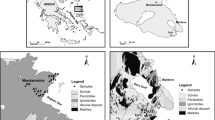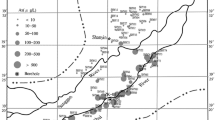Abstract
High arsenic concentrations in groundwater have been documented in La Laguna Region (LLR) in arid northern Mexico, where arsenic poisoning is both chronic and endemic. A heated debate has continued for decades on its origin. LLR consisted of a series of ancient connected lakes that developed at the end of a topographic depression under closed basin conditions. This study addresses the isotopic, chemical composition of the groundwater and geochemical modeling in the southeasternmost part of the LLR to determine the origin of arsenic. Groundwater samples were obtained from a carbonate and granular aquifers and from a clayey aquitard at terminal Viesca Lake. Results show that groundwater originated as meteoric water that reached the lakes mainly via abundant springs in the carbonate aquifer and perennial flooding of the Nazas–Aguanaval Rivers. Paleo-lake water underwent progressive evaporation as demonstrated by the enrichment of δ18O, δ2H and characteristic geochemical patterns in the granular aquifer and aquitard that resulted in highly saline (>90,000 mS/cm), arsenic-rich (up to 5000 μg/L) paleo-groundwater (>30,000 years BP). However, adsorption or co-precipitation on iron oxides, clay-mineral surfaces and organic carbon limited arsenic concentration in the groundwater. Arsenic-rich groundwater and other solutes are advancing progressively from the lacustrine margins toward the main granular aquifer, due to reversal of hydraulic gradients caused by intensive groundwater exploitation and the reduction in freshwater runoff provoked by dam construction on the main rivers. Desorption of arsenic will incorporate additional concentrations of arsenic into the groundwater and continue to have significant negative effects on human health and the environment.










Similar content being viewed by others
References
Appelo, C. A. J. (2008). Geochemical experimentation and modeling are tools for understanding the origin of As in groundwater in Bangladesh and elsewhere. In A. Appelo (Ed.), Arsenic in groundwater—A world problem Seminar Utrecht, 29 November 2006 (pp. 31–50). Netherlands: Netherlands National Committee of the IAH.
Brouste, L., Marlin, C., & Dever, L. (1997). Geochemistry and residence time estimation of groundwater from the upper aquifer of the Chihuahua desert (Comarca Lagunera, Northern Mexico). Applied Geochemistry, 12, 775–786.
Cebrián, M. E., Albores, A., Aguilar, M., & Blakely, E. (1983). Chronic arsenic poisoning in the north of Mexico. Human Toxicology, 2, 121–133.
Cebrián, M. E., Albores, A., Connelly, J. C., & Bridges, J. W. (1987). Assessment of arsenic effects on cytosolic heme status using tryptophan pyrrolase as an index. Journal of Biochemical Toxicology, 3, 77–86.
Chávez, A., Bogrand, R., Ramirez, J., Perez, H. C., Hernández, M., & Rojas, A. (1964). I. Estudios en una comunidad con arsenicismo crónico endémico. Salud Pública (Public Health), 6(3), 421–433.
Comisión Nacional del Agua (CNA). 1993. Actualización del estudio geohidrológico de la Región Lagunera, Coah-Dgo. (Internal report)
Del Razo, L. M., Arellano, M. A., & Cebrián, M. E. (1990). The oxidation states of arsenic in well-water from a chronic arsenicism area of northern México. Environmental Pollution, 64, 143–153.
Del Razo, L. M., García-Vargas, G. G., Albores, A., Gonsebatt, M. E., Montero, R., Ostrosky-Wegman, P., et al. (1997). Altered profile of urinay arsenic metabolites in adults with chronic arsenicism.A pilot study. Archives of Toxicology, 71(1), 211–217.
Eugster, H. P., & Hardie, L. A. (1978). Saline lakes. In A. Lerman (Ed.), Lakes—Chemistry, geology, physics (pp. 237–293). New York: Springer.
Fetter, C. W. (1993). Contaminant hydrogeology. USA: Macmillan Publishing Company. 458p.
Fritz, P., Suzuki, O., Silva, C., & Salati, E. (1981). Isotope hydrology of groundwater in the Pampa del Tamarugal, Chile. Journal of Hydrology, 53, 161–184.
Fujji, M. M., & Swain, W. C. (1995). Areal distribution of trace elements, salinity and major ions in shallow groundwater, Tulare basin, Southern San Joaquin Valley, California. U.S. Geological Survey, Water Resources Investigative Report 95-4048 (p. 67)
García-Vargas, G. G., Del Razo, L. M., Cebrian, M. E., Albores, A., Ostrosky-Wegman, P., Montero, R., et al. (1994). Altered urinary porphyrin excretion in a human population chronically exposed to arsenic in Mexico. Human and Experimental Toxicology, 13, 839–847.
Giménez, J., Martínez, M., de Pablo, J., Rovira, M., & Duro, L. (2007). Arsenic sorption onto natural hematite, magnetite and goethite. Journal of Hazardous Materials, 141, 575–580.
Gonsebatt, M. E., Salazar, A. M., Montero, R., Guzmán, P., Blas, J., Del Razo, L. M., et al. (1997). Cytogenic effects in human exposure of arsenic. Mutation Research, 386, 219–228.
Hardie, L. A., & Eugster, H. P. (1970). The evolution of closed basin brines. Mineralogical Society of America Special Publication, 3, 273–290.
Harvey, C. F., Ashfaque, K. N., Yu, W., Badruzzaman, A. B. M., Ali, M. A., Oates, P. M., et al. (2006). Groundwater dynamics and arsenic contamination in Bangladesh. Chemical geology, 228, 112–136.
Harvey, C. F., Swartz, C. H., Badruzzaman, A. B. M., Keon-Blute, N., Yu, W., Ali, M. A., et al. (2002). Arsenic mobility and groundwater extraction in Bangladesh. Science, 298, 1602–1606.
IARC. (2004). Monographs on the evaluation of carcinogenic risk to humans (Vol. 84). http://www.inchem.org/documents/iarc/vol84/84-01-arsenic.html)
INEGI. (2007). Carta Topográfica Viesca, 1:250,000. G13-9. (Topographic Map).
Instituto Mexicano de Tecnología del Agua (IMTA). (1992). Estudio hidrogeoquímico e isotópico del acuífero granular de la Comarca Lagunera. Jiutepec, Morelos, México (Internal Report).
Jones, B. F., Eugster, H. P., & Rettig, S. L. (1977). Hydrochemistry of lake Magadi basin, Kenya. Geochimica et Cosmochimica Acta, 41, 53–72.
Khan, A. W., et al. (1997). Arsenic contamination in groundwater and its effect on human health with particular reference to Bangladesh. Journal of Preventive and Social Medicine, 16(1), 65–73.
Kharaka, Y. K., & Carothers, W. W. (1986). Oxygen and hydrogen isotope geochemistry of deep basin brines. In P. Fritz & J. C. Fontes (Eds.), Handbook of Environmental Isotope Geochemistry, 2. The Terrestrial Environment B (pp. 305–353). Amsterdam: Elsevier.
Latorre, C. D., Lesser, J. M., Quijano, L. L, & Payne, B. R. (1981). Isótopos ambientales aplicados al estudio de la interconexión de los acuíferos calizos y de rellenos de la Región Lagunera de Coahuila-Durango, México. In Interamerican symposium on isotope hydrology.
Lindberg, R. D., & Runnells, D. D. (1984). Ground water redox reactions: An analysis of equilibrium state applied to Eh measurements and geochemical modeling. Science, 225, 925–927.
Mamindy-Pajany, Y., Hurel, C., Marmier, N., & Roméo, M. (2009). Arsenic adsorption onto hematite and goethite. C.R. Chimie, 12, 876–881.
Mayer, P. F. (1967). Resumen de la geología de la hoja Viesca 13R-1(5). Mexico: Institute for Geology at the Nacional University of Mexico
McArthur, J. M., Ravenscroft, P., Safiula, S., & Thirlwall, M. F. (2001). Arsenic in groundwater: Testing pollution mechanism fro sedimentary aquifers in Bangladesh. Water Resources Research, 37(1), 109–117.
Mejía-González, M. A., González-Hita, L., Briones-Gallardo, R., & Cardona-Benavides, A. (2014). Mecanismos que liberan arsénico al agua subterránea de la Comarca Lagunera, estados de Coahuila y Durango, México. Tecnología y Ciencias del Agua, V(1), 71–82.
Ortega, G. A., Cherry, J. A., & Aravena, R. (1997). Origin of pore water and salinity in the lacustrine Aquitard overlying the regional aquifer of Mexico City. Journal of Hydrology, 197, 47–69.
Ortega-Guerrero, A. (2003). Origin and geochemical evolution of groundwater in a closed-basin aquitard Northern Mexico. Journal of Hydrology, 284, 26–44.
Ortega-Guerrero, M. A. (2004). The evaporative concentration of arsenic in groundwater, La Laguna Region, Mexico. Abstract at the International Geologic Congress, Florence, Italy.
Ostrosky-Wegman, P., Gonsebatt, M. E., Montero, R., Vega, L., Barba, H., Espinosa, J., et al. (1991). Lymphocyte proliferation kinetics and genotoxic findings in a pilot study on individuals chronically exposed to arsenic in Mexico. Mutation Research, 250, 477–482.
Parkhurst, D. L., Thorstenson, D. C., & Plummer, L. N. (1980). PHREEQE, a computer program for geochemical calculations. US Geological Survey Water Resources Investigations Report, 80-96.
Plummer, L. N., Parkhush, D. L., Fleming, G. W., & Duncle, S. A. (1988). A computer program incorporating Pitzer´s equations for calculation of geochemical reactions in brines. US Geological Survey water Resources Investigation report, 88-4153.
Rahman, M. A., Hasan, M. M. D., Siddique, N.-E.-A., & Alam, A. M. S. (2011). Mobilization of arsenic with iron, manganese and copper in borehole sediments of the River Jamuna. Joournal of the Bangladesh Chemical Society, 25(1), 30–37.
Robles-Osorio, M. L., Pérez-Maldonado, I. N., Martín del Campo, D., Montero-Perea, D., Avilés-Romo, I., Sabath-Silva, E. (2012). Urinary arsenic levels and risk of renal injury in a cross-sectional study in open population. Revista de Investigación Clínica, 64, 609–614.
Secretaría de Agricultura y Recursos Hidráulicos (SARH). (1980). Nota informativa acerca de la actualización de las condiciones geohidrológicas de la Comarca Lagunera. Mexico: Coahuila-Durango.
Secretaría de Salud (SSA). (2000). Modificación a la Norma Oficial Mexicana NOM-127-SSA1-1994, Salud ambiental. Agua para uso y consumo humano. Límites permisibles de calidad y tratamientos a que debe someterse el agua para su potabilización.
Smith, A. H., Lingas, E. O., & Rahman, M. (2000). Contamination of drinking-water by arsenic in Bangladesh: A public health emergency. Bulletin of the World Health Organization, 78(9), 1093–1103.
Splieethoff, H. M., Mason, R. P., & Hemond, H. F. (1995). Interannual variability in the speciation and mobility of arsenic in a dimitic lake. Environmental Science and Technology, 29(8), 2157–2161.
Swartz, R. J., Thyne, G. D., & Gillespie, J. M. (1996). Dissolved arsenic in the Kern Fan San Joaquin Valley, California: Naturally occurring or anthropogenic. Environmental Geosciences, 3(3), 143–153.
Welch, A. H., Lico, M. S., & Hughes, J. L. (1988). Arsenic in ground water of the United States. Ground Water, 26(3), 333–347.
Welch, A. H., Westjohn, D., Helsel, D. R., & Wanty, R. B. (2000). Arsenic in ground water of the United States: Occurrence and Geochemistry. Ground Water, 38(4), 589–604.
WHO. (2010). Exposure to arsenic: A major public health concern. (www.who.int/ipcs/features/arsenic.pdf?ua=1)
Acknowledgments
Financial support was provided by CONACYT Mexico Grant 3454P-T. Thanks to the two anonymous reviewers whose comments improved the manuscript. This document is dedicated to the people at the La Laguna Region.
Author information
Authors and Affiliations
Corresponding author
Rights and permissions
About this article
Cite this article
Ortega-Guerrero, A. Evaporative concentration of arsenic in groundwater: health and environmental implications, La Laguna Region, Mexico. Environ Geochem Health 39, 987–1003 (2017). https://doi.org/10.1007/s10653-016-9866-5
Received:
Accepted:
Published:
Issue Date:
DOI: https://doi.org/10.1007/s10653-016-9866-5




